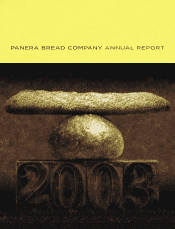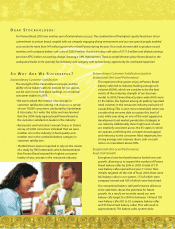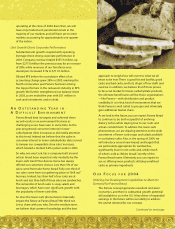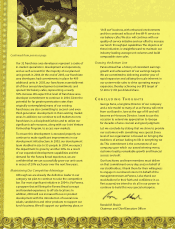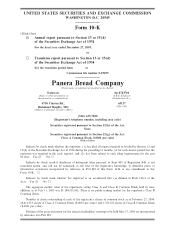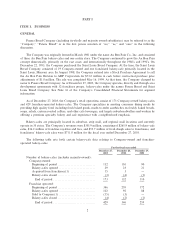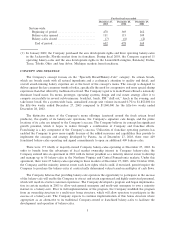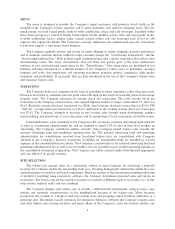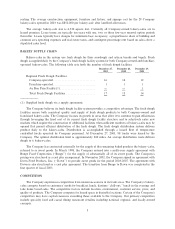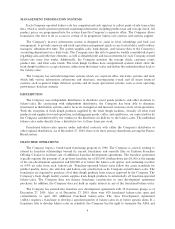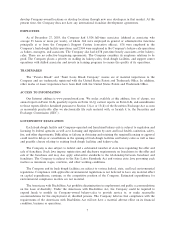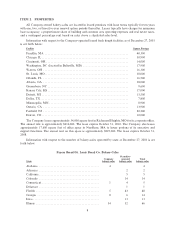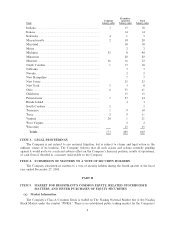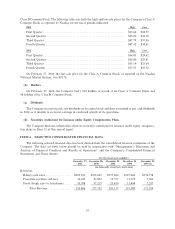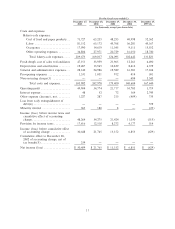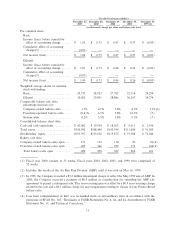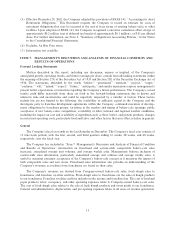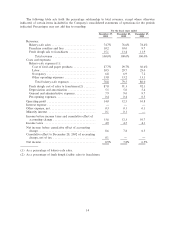Panera Bread 2003 Annual Report Download - page 8
Download and view the complete annual report
Please find page 8 of the 2003 Panera Bread annual report below. You can navigate through the pages in the report by either clicking on the pages listed below, or by using the keyword search tool below to find specific information within the annual report.MENU
The menu is designed to provide the Company's target customers with products which build on the
strength of the Company's bakery expertise and to meet customers' new and ever-changing tastes. The key
menu groups are fresh baked goods, made-to-order sandwiches, soups, and cafe beverages. Included within
these menu groups are a variety of freshly baked bagels, breads, muÇns, scones, rolls, and sweet goods; made-
to-order sandwiches; hearty, unique soups; custom roasted coÅees and cafe beverages such as hot or cold
espresso and cappuccino drinks. The Company's concept emphasizes the sophisticated specialty and artisan
breads that support a take-home bread business.
The Company regularly reviews and revises its menu oÅerings to satisfy changing customer preferences
and to maintain customer interest within its target customer groups, the ""bread loving trend-setters'' and the
""bread loving traditionalists.'' Both of these target customer groups seek a quality experience that reÖects their
discriminating tastes. The major characteristic that sets these two groups apart is the more enthusiastic
embrace of new and nutritional menu items by the ""Trend-Setters.'' New menu items are developed in test
kitchens and then introduced in a limited number of the Company's bakery-cafes to determine customer
response and verify that preparation and operating procedures maintain product consistency, high quality
standards, and proÑtability. If successful, they are then introduced in the rest of the Company's bakery-cafes
and franchise bakery-cafes.
MARKETING
The Company believes it competes on the basis of providing an entire experience rather than price only.
Pricing is structured so customers perceive good value with high quality food at reasonable prices to encourage
frequent visits. The Company measures its average check per transaction. The total average check per
transaction at the Company-owned bakery-cafes opened eighteen months or longer at December 27, 2003 was
$6.61. Breakfast average check per transaction was $4.86, lunch average check per transaction was $7.65, PM
""chill out'' average check per transaction was $6.67, and lunch in the evening average check per transaction
was $7.42. The Company attempts to increase its per location sales through menu development, product
merchandising and promotions at every day prices and by sponsorship of local community charitable events.
Franchised bakery-cafes contribute to the Company 0.4% of sales to a national advertising fund and 0.4%
of sales as a marketing administration fee and are required to spend 2.0% of sales in their local markets on
advertising. The Company contributes similar amounts from Company-owned bakery-cafes towards the
national advertising fund and marketing administration fee. The national advertising fund and marketing
administration fee contributions received from franchised bakery-cafes are consolidated with Company
amounts in the Company's Ñnancial statements. Liabilities for unexpended funds are included in accrued
expenses in the consolidated balance sheets. The Company's contributions to the national advertising fund and
marketing administration fee as well as its own media costs are recorded as part of other operating expenses in
the consolidated statements of operations. The Company may utilize external media when deemed appropriate
and cost eÅective in speciÑc markets.
SITE SELECTION
The bakery-cafe concept relies on a substantial volume of repeat business. In evaluating a potential
location, the Company studies the surrounding trade area, obtaining demographic information within that area
and information on breakfast and lunch competitors. Based on analysis of this information including utilization
of predictive modeling using proprietary software, the Company determines projected sales and return on
investment. The Panera concept has proven successful in a number of diÅerent types of real estate (i.e., in-line
strip centers, regional malls and free-standing).
The Company designs each bakery-cafe to provide a diÅerentiated environment, using in many cases
Ñxtures and materials complementary to the neighborhood location of the bakery-cafe. Many locations
incorporate the warmth of a Ñreplace and cozy seating areas and groupings which facilitate utilization as a
gathering spot. The design visually reinforces the distinctive diÅerence between the Company's bakery-cafes
and other bakery-cafes serving breakfast and lunch. Many of the Company's cafes also feature outdoor cafe
4

